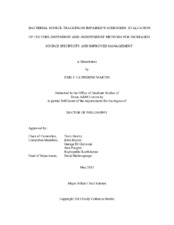| dc.contributor.advisor | Gentry, Terry | |
| dc.creator | Martin, Emily C | |
| dc.date.accessioned | 2013-10-03T15:01:40Z | |
| dc.date.available | 2013-10-03T15:01:40Z | |
| dc.date.created | 2013-05 | |
| dc.date.issued | 2013-05-02 | |
| dc.date.submitted | May 2013 | |
| dc.identifier.uri | https://hdl.handle.net/1969.1/149494 | |
| dc.description.abstract | Bacterial contamination due to excessive levels of bacteria is a confounding problem and remediation of impaired watersheds relies on the detection of fecal indicator bacteria and then assessing the source of said bacteria. Bacterial source tracking (BST) is an approach for assessing potential sources of this contamination. The purpose of this study was to utilize both cultivation-independent and –dependent methods to improve the ability to track sources of fecal contamination. First, E. coli community composition was assessed across three standard water quality assessments including USEPA Methods 1603 and 1604, and Colilert®, to determine their impact on BST library-based performance. Results indicate that the three assessed methods of enumeration and isolation may select for different populations of E. coli and standardized methods may be warranted if library-dependent BST is part of a research plan. Next, BST techniques were used to enumerate and characterize E. coli communities across various dairy manure management techniques used in the Leon River watershed in central Texas to determine effectiveness of BST efforts in tracking contamination from dairy manure. Results of this study indicated that manure and effluent management strategies which employed means to remove solids from the manure tended to decrease the levels of E. coli in the effluent. Some E. coli genotypes were found across the managerial treatments even though there were no clear seasonal trends or site groupings among the dataset. The vast majority of the isolates classified using the Texas E. coli BST library were correctly classified back to their major source class, thus increasing confidence in the methods currently being utilized to track dairy fecal contributions in this Central Texas watershed. Finally, deer bacterial fecal communities from south and central Texas were analyzed using 454-pyrosequencing to assess the potential for the development of a deer-specific BST marker. Microbial communities did not cluster by site or year suggesting that deer fecal communities in these Texas regions are stable over time and could be amenable to marker development. | en |
| dc.format.mimetype | application/pdf | |
| dc.language.iso | en | |
| dc.subject | bacterial source tracking | en |
| dc.subject | E. coli | en |
| dc.title | Bacterial Source Tracking in Impaired Watersheds: Evaluation of Culture-Dependent and -Independent Methods for Increased Source Specificity and Improved Management | en |
| dc.type | Thesis | en |
| thesis.degree.department | Soil and Crop Sciences | en |
| thesis.degree.discipline | Soil Science | en |
| thesis.degree.grantor | Texas A&M University | en |
| thesis.degree.name | Doctor of Philosophy | en |
| thesis.degree.level | Doctoral | en |
| dc.contributor.committeeMember | Feagley, Sam | |
| dc.contributor.committeeMember | Brooks, John | |
| dc.contributor.committeeMember | Di Giovanni , George | |
| dc.contributor.committeeMember | Karthikeyan, Raghupathy | |
| dc.type.material | text | en |
| dc.date.updated | 2013-10-03T15:01:40Z | |


